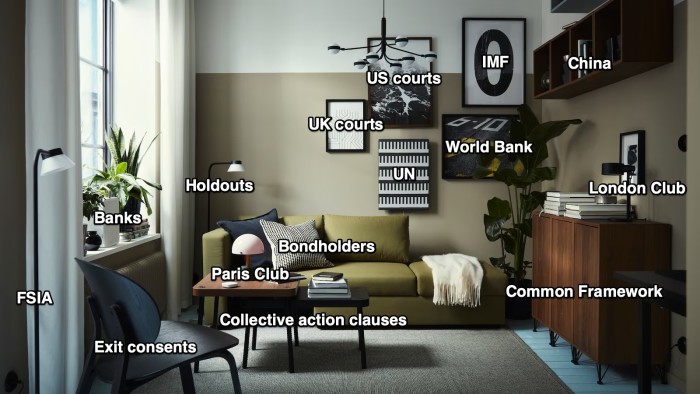Unlock the Editor’s Digest for free
Roula Khalaf, Editor of the FT, selects her favourite stories in this weekly newsletter.
As a recent paper on the subject pointed out, what is often described as the international financial architecture is better described as “furniture”, with sofas, tables, lamps and paintings constantly rearranged around.
That is particularly true of sovereign debt restructuring. Given that there are no international laws or courts that oversee government bankruptcies, the various fixtures (contracts, custom, geopolitical expediency etc) are in constant flux.
That came to FT Alphaville’s mind when belatedly reading Lazard’s review of what it terms the “2020-25 sovereign debt crisis”, and the bank’s main takeaways from the period.
Lazard has the biggest sovereign debt restructuring advisory out there, and over the past five years it worked for Argentina, Ecuador, Ethiopia, Ghana, Lebanon, Suriname, Sri Lanka and Zambia — helping restructure about $200bn of debt.
It’s therefore well-placed to reflect on what we’ve learned from the spate of state debt workouts and what might lie ahead. Here are the review’s main points, with Lazard’s emphasis below:
• . . . While a consensus seems to emerge that there are no major risks of sovereign default in the near-term, we rather argue that shock absorption capacity has diminished across the board and debt tolerance has often reached its limits. This makes the question of the effectiveness of the collective debt resolution framework (notably the G20 Common Framework) highly relevant.
• Looking at the past five years, we argue that the collective process has in fact worked as well as the circumstances permitted — but in a slow and tortuous way. The domination of investors largely impervious to regulatory pressure (bondholders and Chinese commercial lenders) and of bilateral creditors having a lower degree of agency in the multilateralism born in 1944 in Bretton Woods has made it impossible for the IMF to be the powerful dealmaker it was once in the 1980s.
• Consequently, the international infrastructure for debt relief has had to cope with a world where the financial effort required by creditors — as set by the IMF — is systematically challenged, and where inter-creditor issues are obsessively scrutinized by official and private creditors lacking trust in each other.
• This has led to endless debates about what comparability means, to the multiplication of state contingent instruments — creditors asking for compensation in case the IMF projections prove pessimistic — and to the proliferation of claw back clauses to ensure that no creditor may end up being better treated in the future. In the same vein, comparability concerns amongst external creditors have led to lifting the taboo of domestic debt restructuring to share the burden of pain with a greater pool of creditors.
This was all extremely apparent in the protracted Zambian debt restructuring, which took nearly four years to resolve and might still lead to a festering debt problem. Anyway, back to Lazard’s review, which chooses to put a slightly more optimistic slant on things.
• Still, the overwhelming benefit of the current approach, however imperfect, has been to bring China, a major bilateral creditor, in the multilateral discussion, with adequate voice.
• Looking ahead, we see many clouds on the horizon for “Frontier finance”, with some silver lining here and there, notably the possibility to transform abundant carbon absorptive natural assets into a green currency to repay debt.
• In particular, we see a number of complex issues interacting in a way that will complicate the adequate funding of these countries’ sustainable development needs. For instance, the issue of the hierarchy of claims is likely to be an important theme looking forward. As many concessional creditors step in to finance governments in an affordable way. subordination risk increases for non-protected creditors. But, as super-senior claims proliferate, the Preferred Creditor Status claimed by several public institutions may itself well appear as relative rather than absolute. Creditors* hierarchy is going to become an important though fluid issue.
• This issue will cloud the horizon just as the risk of crystallization of contingent financial liabilities increases, in a way that remains in our view imperfectly analyzed.
• As a result, Frontier finance will be probably marked in the future by multiple equilibria, which, if the issue is not addressed, will raise the cost of capital in these countries.
You can read the whole thing there. If you’re into sovereign debt restructuring (and if you’re not, you should be!) then it’s a great overview of what has been, what it means and what might be as a result. Though we suspect Beijing and some bondholders might quibble with some aspects.
Alphaville’s main thought is that most of the countries that fell into debt distress in recent years have mostly been fairly small and, well, economically unimportant. That has meant their problems have been fairly contained, and the bigger countries and multinational institutions have — aside from occasional performative hand-wringing — been largely OK with letting things muddle along.
As long as the problems remain contained in the smaller “frontier” countries, that might be fine. Well, not obviously fine — for the countries in question a festering, chronic and slow-to-resolve debt crisis can be as painful as an acute one — but in the grand scheme of things not cataclysmic. And certainly not when the future of the Bretton Woods institutions themselves are being questioned.
However, things might look a bit different if the latest IMF programmes for bigger countries like Egypt and Pakistan once again end in failure. Or if simmering concerns about Nigeria – where credit-default swaps now trade with upfront costs – are realised.
Further reading:
— How to speed up sovereign debt restructuring (FTAV)
— Sovereign debt architecture is messy and here to stay (FTAV)
— How to restructure sovereign debt (FTAV)
https://www.ft.com/content/171582dd-1e96-4ef7-8a3b-47579310c7d2


